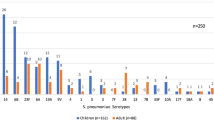Abstract
Group A streptococcus (GAS) is considered to be a major pathogen of bacterial tonsillopharyngitis in children. Although GAS is generally susceptible to penicillin, macrolides are often used as the second-line treatment. Over the last several decades, the rising macrolide resistance of GAS has been detected in several countries. With the current study, we aimed to determine the development of macrolide resistance at our paediatric centre. From March 2006 to May 2009, 350 GAS isolates were tested for susceptibility to erythromycin, azithromycin, clindamycin, penicillin and cefotaxime. Macrolide-resistant isolates were screened for the presence of genes related to macrolide resistance (mefA, ermB, ermTR, prtF1). In comparison to a prior study at our hospital, the erythromycin resistance rate decreased significantly from 13.6 to 2.6%. This effect may be attributable to a more restrictive use of macrolides in children in our region.
Similar content being viewed by others
References
Bisno AL, Gerber MA, Gwaltney JM Jr, Kaplan EL, Schwartz RH; Infectious Diseases Society of America (2002) Practice guidelines for the diagnosis and management of group A streptococcal pharyngitis. Clin Infect Dis 35:113–125
Liu X, Shen X, Chang H, Huang G, Fu Z, Zheng Y, Wang L, Li C, Liu L, Shen Y, Yang Y (2009) High macrolide resistance in Streptococcus pyogenes strains isolated from children with pharyngitis in China. Pediatr Pulmonol 44(5):436–441
Clancy J, Petitpas J, Dib-Hajj F, Yuan W, Cronan M, Kamath AV, Bergeron J, Retsema JA (1996) Molecular cloning and functional analysis of a novel macrolide-resistance determinant, mefA, from Streptococcus pyogenes. Mol Microbiol 22(5):867–879
Leclercq R, Courvalin P (1991) Bacterial resistance to macrolide, lincosamide, and streptogramin antibiotics by target modification. Antimicrob Agents Chemother 35(7):1267–1272
Seppälä H, Skurnik M, Soini H, Roberts MC, Huovinen P (1998) A novel erythromycin resistance methylase gene (ermTR) in Streptococcus pyogenes. Antimicrob Agents Chemother 42(2):257–262
Facinelli B, Spinaci C, Magi G, Giovanetti E, Varaldo PE (2001) Association between erythromycin resistance and ability to enter human respiratory cells in group A streptococci. Lancet 358:30–33
Haller M, Fluegge K, Arri SJ, Adams B, Berner R (2005) Association between resistance to erythromycin and the presence of the fibronectin binding protein F1 gene, prtF1, in Streptococcus pyogenes isolates from German pediatric patients. Antimicrob Agents Chemother 49(7):2990–2993
NICE Short Clinical Guidelines Technical Team (2008) Respiratory tract infections—antibiotic prescribing. Prescribing of antibiotics for self-limiting respiratory tract infections in adults and children in primary care. National Institute for Health and Clinical Excellence, London
Bingen E, Fitoussi F, Doit C, Cohen R, Tanna A, George R, Loukil C, Brahimi N, Le Thomas I, Deforche D (2000) Resistance to macrolides in Streptococcus pyogenes in France in pediatric patients. Antimicrob Agents Chemother 44(6):1453–1457
Fluegge K, Supper S, Siedler A, Berner R (2004) Antibiotic susceptibility in neonatal invasive isolates of Streptococcus agalactiae in a 2-year nationwide surveillance study in Germany. Antimicrob Agents Chemother 48(11):4444–4446
Neeman R, Keller N, Barzilai A, Korenman Z, Sela S (1998) Prevalence of internalisation-associated gene, prtF1, among persisting group-A streptococcus strains isolated from asymptomatic carriers. Lancet 352(9145):1974–1977
Cantón R, Loza E, Morosini MI, Baquero F (2002) Antimicrobial resistance amongst isolates of Streptococcus pyogenes and Staphylococcus aureus in the PROTEKT antimicrobial surveillance programme during 1999–2000. J Antimicrob Chemother 50(Suppl S1):9–24
van der Linden M, Imöhl M, Reinert RR (2008) 4.1.1 Streptococcus spp. 4.1.1.1 Streptococcus pyogenes. In: GERMAP 2008. Antibiotika-Resistenz und -Verbrauch. ISBN 978-3-00-025097-2, p. 29
Seppälä H, Klaukka T, Lehtonen R, Nenonen E, Huovinen P (1995) Outpatient use of erythromycin: link to increased erythromycin resistance in group A streptococci. Clin Infect Dis 21(6):1378–1385
Malhotra-Kumar S, Lammens C, Coenen S, Van Herck K, Goossens H (2007) Effect of azithromycin and clarithromycin therapy on pharyngeal carriage of macrolide-resistant streptococci in healthy volunteers: a randomised, double-blind, placebo-controlled study. Lancet 369(9560):482–490
Zavadska D, Bērziņa D, Drukaļska L, Pugacova N, Miklasevics E, Gardovska D (2010) Macrolide resistance in group A beta haemolytic Streptococcus isolated from outpatient children in Latvia. APMIS 118(5):366–370
Kern WV, Schröder H (2008) 2.1 Antibiotikaverbrauch im ambulanten Bereich. In: GERMAP 2008. Antibiotika-Resistenz und -Verbrauch. ISBN 978-3-00-025097-2, p. 15
Malli E, Tatsidou E, Damani A, Pantelidi K, Petinaki E, Skoulakis C, Drougka E, Spiliopoulou I (2010) Macrolide-resistant Streptococcus pyogenes in Central Greece: prevalence; mechanism and molecular identification. Int J Antimicrob Agents 35(6):614–615
Green M, Martin JM, Barbadora KA, Beall B, Wald ER (2004) Reemergence of macrolide resistance in pharyngeal isolates of group A streptococci in southwestern Pennsylvania. Antimicrob Agents Chemother 48(2):473–476
Acknowledgements
We thank Ursula Schmid, Käthe Brell and Susanne Fukala for their excellent technical assistance in the resistance testing.
Conflict of interest
The authors declare that they have no conflict of interest.
Author information
Authors and Affiliations
Corresponding author
Rights and permissions
About this article
Cite this article
Farmand, S., Henneke, P., Hufnagel, M. et al. Significant decline in the erythromycin resistance of group A streptococcus isolates at a German paediatric tertiary care centre. Eur J Clin Microbiol Infect Dis 31, 707–710 (2012). https://doi.org/10.1007/s10096-011-1362-3
Received:
Accepted:
Published:
Issue Date:
DOI: https://doi.org/10.1007/s10096-011-1362-3



